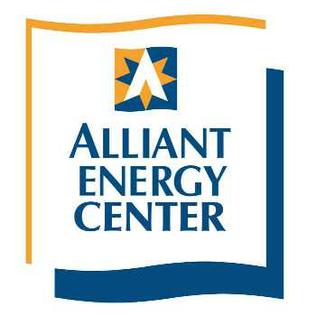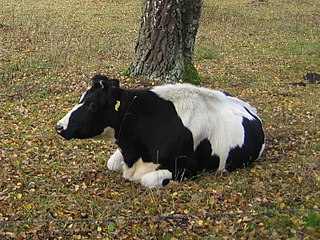
The Guernsey is a breed of dairy cattle from the island of Guernsey in the Channel Islands. It is fawn or red and white in colour, and is hardy and docile. Its milk is rich in flavour, high in fat and protein, and has a golden-yellow tinge due to its high β-carotene content. The Guernsey is one of three Channel Island cattle breeds; the other two are the Alderney, which is now extinct, and the Jersey.

The Dairy Shorthorn is a British breed of dairy cattle. It derives from the Shorthorn cattle of Teesside, in the North Riding of Yorkshire and in Northumbria in north-eastern England. The Shorthorn was for this reason at first known as the Durham or Teeswater.

The Brown Swiss or American Brown Swiss is an American breed of dairy cattle. It derives from the traditional triple-purpose Braunvieh of the Alpine region of Europe, but has diverged substantially from it. It was selectively bred for dairy qualities only, and its draft and beef capabilities were lost. Milk yield was measured in 2013 at 10231 kg (22600 lb) per year; the milk has about 4% butterfat and 3.5% protein and is suitable for making cheese.

The Royal Agricultural Winter Fair (RAWF), also known as The Royal, is an annual agricultural fair that is held in Toronto, Ontario, Canada during the first two weeks of November. It was inaugurated in 1922 in the Coliseum, on the grounds of Exhibition Place. It has since been expanded to also take up the Enercare Centre and remains an important exhibit for livestock breeders. Elizabeth II, as Queen of Canada, was the fair's royal patron. Members of the Canadian Royal Family have also been guests of honour at the fair. It is the largest indoor agricultural fair in the world.
Hoard's Dairyman is an American agricultural trade publication that focuses on dairy farming. It was founded in 1885 by William D. Hoard as a supplement to the Jefferson County Union and is published in Fort Atkinson, Wisconsin.

Alliant Energy Center is a multi-building complex located in Madison, Wisconsin. It comprises 164 acres (0.66 km2) of greenspace and includes the 255,000-square-foot (23,700 m2) Exhibition Hall, the 10,000-seat Veterans Memorial Coliseum, the 29-acre (0.12 km2) Willow Island and the 22,000-square-foot (2,000 m2) Arena. After completing various stages of planning throughout 2013, it was announced on November 26 that Dane County would be awarding a $20.7 million contract to Miron Construction for the construction of two new multi-use pavilions at the Alliant Energy Center. The exhibition pavilions, which total 290,000 square feet, will be replacing the nine current agricultural barns. Construction began following the Midwest Horse Fair in April 2014 with completion set in time for the 2014 World Dairy Expo in late September. The Center welcomes more than one million people attending more than 500 events annually, ranging from local meetings and banquets to large sporting events and major concerts.

Cutting is a western-style equestrian competition in which a horse and rider work together before a judge or panel of judges to demonstrate the horse's athleticism and ability to handle cattle. Modern competition utilizes a 2+1⁄2 minute performance, called a "run." Each contestant is assisted by four helpers: two are designated as turnback riders, who help to keep cattle from running off to the back of the arena, the other two are designated as herd holders to keep the cattle bunched together and prevent potential strays from escaping into the work area. Cutting cattle are typically young steers and heifers that customarily range in size from 400 to 650 lb. They usually are of Angus or Hereford lineage though may be a mix of crossbred beef cattle, including Charolais Braford or Brahman lineage.

The Red Sindhi is a dairy breed of zebuine cattle. It is believed to originate in western Sindh and in the Las Bela area of Balochistan, now in Pakistan. It is widely kept in Pakistan, where in 2006 there were approximately 3000000 head; there are small numbers in India and in Bangladesh. Other names include Las Bela, Malir and Sindhi.

The Paris International Agricultural Show is an annual agricultural show and trade fair, that takes place at the end of February or beginning of March at the Paris expo Porte de Versailles in Paris, France. It is one of the world's largest and most important agricultural shows, drawing larger crowds than any other in Paris except the Foire de Paris.
The Tipo Carora or Carora is a Venezuelan breed of dairy cattle. It was bred in the early part of the twentieth century by crossing of local Criollo cows with imported Brown Swiss bulls. It is named for its place of origin, the town of Carora in the Venezuelan state of Lara.
Missy is a Holstein cow who was auctioned for $1.2 million in 2009, making her the most expensive cow in the world at that time.

Cattle are large, domesticated, bovid ungulates. They are prominent modern members of the subfamily Bovinae and the most widespread species of the genus Bos. Mature female cattle are referred to as cows and mature male cattle are referred to as bulls. Colloquially, young female cattle (heifers), young male cattle, and castrated male cattle (steers) are also referred to as "cows".
The Rockingham County Fair has been dubbed by the Los Angeles Times as one of the best rural county fairs in the United States for the usual showcases that include: tractor pulls, a demolition derby, amusement rides, an antique auto show, a flea market, and country-western concerts. Local specialties brought to the fair are quince and crab apple jellies, gingerbread, peanut brittle, canned huckleberries and sauerkraut.

Yakutian cattle, Саха ынаҕа in the Sakha language, are a cattle landrace bred north of the Arctic Circle in the Republic of Sakha. They are noted for their extreme hardiness and tolerance towards freezing temperatures.
John Thomas Cole was an Australian dairy farmer and cattle breeder.
The Dairy Show is an annual British agricultural show, organised by the Royal Association of British Dairy Farmers. It was founded in 1876 and was first held at the Agricultural Hall in Islington, London; it was later held at Olympia, London, and then moved to the National Agricultural Exhibition Centre at Stoneleigh Park, in Warwickshire. It is now held as part of the annual Livestock Event at the National Exhibition Centre, in Birmingham in the Midlands.

The Swedish Friesian, Swedish: 'Svensk Låglandsboskap', often abbreviated to SLB, is a Swedish breed of dairy cattle. It was established in about 1870 from imports of cattle of Dutch Friesian or German Black Pied type. From about 1970 it has been systematically cross-bred with the American Holstein-Friesian breed, to the point that the original Swedish type may be extinct. The name Swedish Holstein may also be used.It is a type of Swedish cattle breed.

Dairy cattle evaluation is the process of placing a group of dairy cows in order from most to least desirable based on milk production and longevity, where each animal is compared against the "ideal" animal. Dairy cattle are evaluated based on physical traits that equate to high milk production, with slight variations between different breeds. Dairy cattle evaluation is primarily used by producers to select the best cows to keep in the herd.

The Dutch Belted or Dutch Belt is an American breed of dairy cattle. It derives from the Lakenvelder of Germany and the Netherlands, of which examples were imported to the United States from 1838. It became an important dairy breed in the early twentieth century, but could not compete with the Holstein-Friesian. By 1970 it was close to extinction; from 1993 the American Livestock Breeds Conservancy was active in the recovery of the breed. In 2021 it was listed as "critical" on the watchlist of the conservancy.












